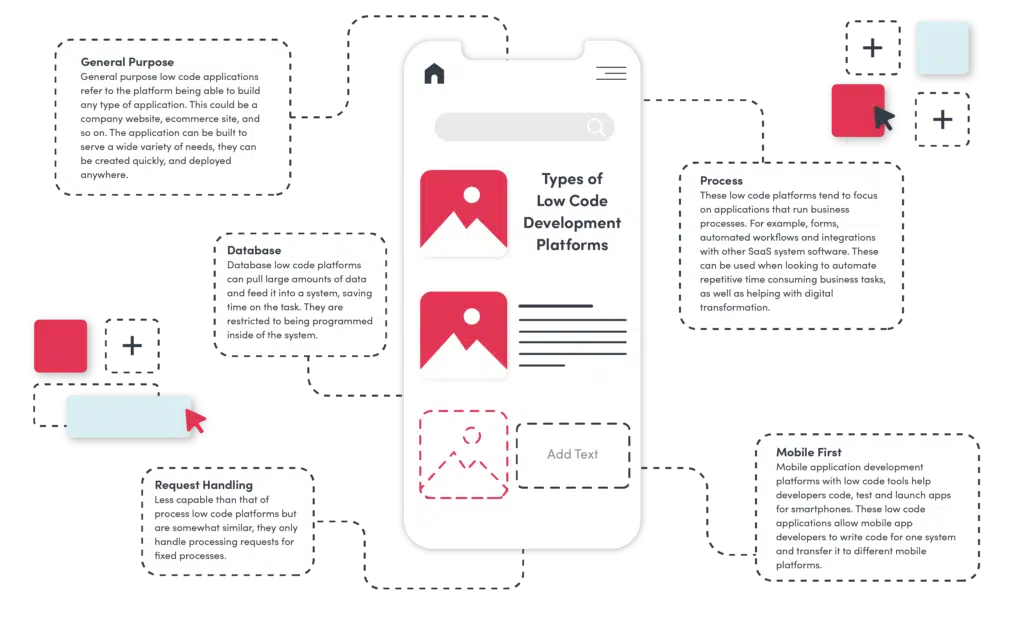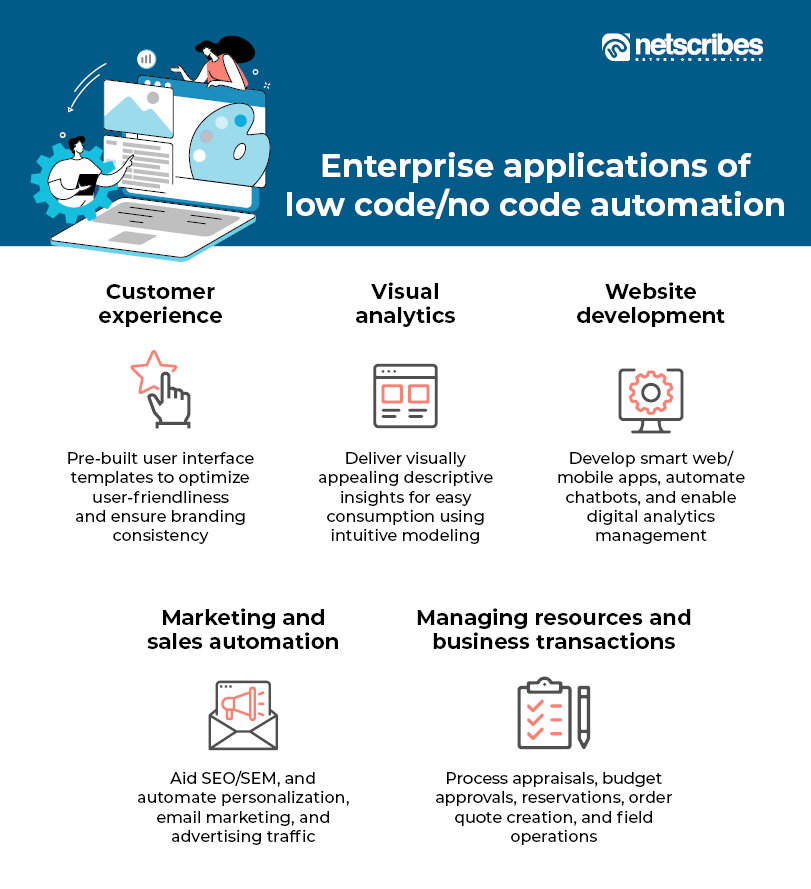Recommended Ideas For Picking Legacy application modernization with Low-code
Wiki Article
Advantages Of Low-Code Application Development In Terms Of Integration Capabilities
Low-code development is a fantastic way to build applications that seamlessly integrate with diverse platforms and services. Here are some benefits of pre-built APIs and connectors:
Wide Selection of Connectors. Low-code software typically includes a wide range of built-in connections to the enterprise system that are widely used (e.g. cloud-based services, databases, CRM). This eases the process of integration with these systems.
API Integration: Many Low-Code platforms include out-of box API integration features, which allow developers to quickly connect external services and data resources.
User-Friendliness:
Drag-and–Drop Interfaces: Many integration tasks can be easily completed using drag-and–drop interfaces. This allows for developers and other non-developers to build complex systems without the need for extensive programming.
Visual Workflow Builders : Software for creating workflows and data flow which are visually represented help to understand and set up integrations in a much more simple manner.
Standardized Integration Methods:
SOAP and RESTful Service The support for web services standards like SOAP and REST allows easy integration with many different systems.
OData Standards: OData standards permit the simple manipulation and retrieval of data across a variety of platforms and applications.
Real-Time Data Synchronization:
Real-Time Integrations: Low-code platforms can handle the real-time synchronization of data among systems, applications as well as databases. This ensures that the data is always up-to date and consistent within an company.
Event-Driven Architecture: Some platforms support event-driven architectures, enabling applications to respond to events in real-time. This is crucial for interactive and dynamic applications.
Legacy System Integration:
Interconnecting Old and New Systems Low-code platforms usually provide tools to integrate with older systems, allowing companies to upgrade their IT infrastructure without completely overhauling existing systems.
Data Migration Tools: These built-in instruments for data migration make it easier to transfer of old systems to applications developed on low-code platforms.
Integration of Third-Party Services:
Cloud Services Integration: Easy scaling and deployment of applications is made possible by seamless integration with cloud services such as AWS, Azure and Google Cloud.
Business Applications Integration: Low-code platforms are able to integrate with various business applications like Salesforce, SAP, Microsoft Dynamics, etc. to create a seamless workflow that spans different business functions.
Simplified management of data:
Unified data models: Some platforms offer low-code support for unified data models to simplify data management across different systems.
Data Connectors - Pre-configured connectors which allow for simple access to, as well as manipulation of, data from diverse sources.
Security and Compliance
Secure Integrations - Low-code platforms are designed to ensure that all integrations adhere to the security protocols and standards. This helps protect data both in transit and when it is being stored.
Features for Compliance - These platforms come with features that ensure the integrations are compliant to regulatory regulations.
Extensibility:
Low-code platforms permit the creation of customized scripts and code to meet more complex integration requirements. The flexibility offered without compromising ease of use.
Plug-in Ecosystem A collection of plugins and extensions that can further extend the integration capabilities that allow users to include new functions as needed.
Overall, integration capabilities within low-code application development platforms permit them to provide a robust platform for developing connected, efficient, scalable, and connected applications. They help connect various systems. They also help improve the flow of data. Take a look at the recommended next page for Low-code Platform for application development for blog examples including cross platform mobile app development, azure sql, app platforms, mobile app development platforms, app development platform, application modernization software, rad application development, mobile app development platforms, database in azure, software for app development and more.

The Advantages Of Low-Code Development For Governance And Security
Low-code application development offers a variety of benefits for security and governance. This is essential to ensure that applications comply with the regulations, are secure and well-managed throughout their lifetime. These are the major benefits.
Unified Manage Console: Lowcode-based platforms usually offer a management console that allows administrators to manage and supervise applications.
Role-Based Access Control RBAC (RBAC). These systems typically provide robust access control based on roles, allowing administrators the ability to define and apply their own access rules. This ensures that only authorized users can access or modify certain areas of an application.
Compliance and Regulatory Adherence:
Features of compliance: Many platforms using low-code have been constructed to comply to industry standards. They offer tools and frameworks to help ensure that the applications are compliant with these standards.
Audit Trails and Logging Comprehensive logs and audit trails can be integrated to enable companies to monitor changes, monitor access and ensure the compliance.
Increase Security Measures
Data Encryption Low-code systems typically come with built-in encryption of data in transit and at rest, protecting sensitive information.
Security Certifications A lot of low-code vendors have security certificates (e.g. ISO 27001, SOC 2 ) that demonstrate compliance with high security standards. This adds additional confidence for the customers.
Automated Security Updates
Regular updates and patching Low-code platforms can handle the majority of security patches and updates in a way. They ensure that applications are secure from the latest threats without having developers intervene manually.
Security Monitoring: Continuous security monitoring tools are used to send real-time notifications and information on security concerns.
Data Governance:
Data Access Policies: These tools permit organizations to define the data access policies, enforce them and keep track of policies. This helps ensure that data are only accessible by authorized users and that they are used in the correct manner.
Data Masking and Anonymization The built-in tools for masking data and anonymization help protect sensitive data, particularly when working in testing and development environments.
Consistent Management of the lifecycle of an application
Development and Deployment pipelines Lowcode platforms usually offer integrated pipelines for development and deployment that include security checks. They provide protection throughout the lifecycle of the application.
Version Control: A unified version control system helps to track changes and allows any modifications made to an application to be tracked. If required the changes can be reversed and the integrity of the application ensured.
User Authentication and Authorization:
Single Sign-On: The ability for SSO as well as other sophisticated authentication methods simplifies the management of users and enhances security.
Multi-Factor Authentication (MFA) A number of platforms have built-in support for multi-factor authentication. It adds an extra layer of security to access applications.
Monitoring Policy Enforcement:
Policy Templates: Low code platforms typically have templates for governance and security which allow companies to swiftly apply policies.
Compliance Monitoring Tools: They provide continuous monitoring and report on compliance status. This allows you to spot potential problems and take action to address them.
Integration into Existing Security Infrastructure
Seamless integration: Low-code platforms can easily be integrated into existing security tools and systems such as firewalls and SIEM solutions (Security Information and Event Management), and identity management systems.
API Security API Security: Built-in API security features make sure that integrations with external systems are secure, protecting the integrity of data as well as ensuring that applications remain secure.
Best Practices and Training
Guided Best Practices : Many platforms provide guidelines and best practices to help non-developers adhere with security standards.
Security Training: Certain providers of low-code provide education and resources in security that will help users understand how to create and maintain secure applications.
Overall, governance and application security benefits ensure that applications will be built and managed securely while remaining in compliance with the regulations and under control. These platforms come with the frameworks and tools required to safeguard sensitive data and enforce policies while maintaining regulatory compliance. Follow the recommended Legacy application modernization with Low-code for more advice including develop web app, build with docker, develop cross platform mobile app, application modernization software, push alerts, develop cross platform mobile app, cloud software applications, azure sql, application modernisation, application development platforms and more.
Advantages Of Low-Code Application Development In Terms Of Vendor Support And Community
Low-code development platforms for applications are a great method to gain support from the vendor as well as community participation. Both are crucial to ensure a successful implementation and ongoing maintenance of the app. These are the major benefits: Support
Comprehensive Technical Support:
Support Teams: Most platforms that make use of low-code offer special support teams that help with technical issues or troubleshooting, as well as guidance.
24/7 Support: Some vendors are available 24/7 This is useful for businesses operating in multiple time zones.
Training and Onboarding
The structured training programs offered by vendors offer structured training courses, such as webinars or certification courses. This helps users quickly get to grips with the platform.
Customized Onboarding A lot of vendors offer customized services that help new clients to use their platform successfully and tailor it specifically to their specific needs.
Updates and Enhancements, Regularly and Enhancements:
Continuous Improvement: Low-code platform vendors generally release periodic updates which include the latest features, performance improvements as well as security patches, making sure that their platform is cutting-edge and secure.
Feedback Integration: Many vendors integrate user feedback into their development cycles. This ensures that the platform adapts to the changing requirements and desires of its customers.
Comprehensive Documentation:
Comprehensive Documentation: A comprehensive and well-organized documentation is typically available, covering everything from basic usage to advanced customization. This allows users to solve problems without assistance.
API References API documentation can aid developers customize and integrate applications with the Low-Code platform.
Consulting and Professional Services:
Expert Consulting: A lot of firms offer consulting services that aid users with complicated implementations and designs for architecture and also strategic planning.
Custom Development Services Some companies offer custom development services for certain capabilities or integrations that are not offered in the box.
Community Support
Active User Communities
Discussion and Forums: Many Low-code platforms feature vibrant online communities where users can ask questions, discuss solutions, and collaborate with each other on best methods.
Meetups and User Groups Virtual or local user groups and meetings provide opportunities to network, learn and sharing knowledge.
Knowledge Sharing and collaboration:
Community-Contributed Resources: Users often share templates, modules, and extensions that they have developed, which can be reused or adapted by others, accelerating development and innovation.
Crowdsourced Solutions: The collective knowledge the experience, expertise and experiences of a community may prove to be a useful tool in problem-solving and finding innovative solutions.
Learning and development:
Community-Led Training: Many communities host workshops, training sessions, and webinars. These are usually run by knowledgeable users who share practical knowledge and more advanced methods.
Online Tutorials and Courses: The community members frequently share and create online tutorials, courses, and tutorials on how to accomplish things that enhance learning resources.
Feedback and Influence
Product Feedback Channels. Community forums usually include channels that allow users to give feedback to the company. This feedback may influence the design and development of new features.
Beta Testing Programs: Members of active communities might be able to take part in beta testing programs, which gives the opportunity to test new features as well as a say in determining the future of the platform.
Recognition and Support:
Community Recognition Programs: Many vendors offer recognition programs that acknowledge the contribution of active members of their community such as MVP (Most Valuable Professionals) programs.
Peer Support: Community members often provide peer support offering their expertise and providing advice for users who aren't as experienced creating a more collaborative and a supportive atmosphere.
Overall, the combination of robust support from the vendor with a vibrant and engaged community results in a comprehensive support eco-system for the development of low-code applications. Users will be able gain access to the experts, resources, and collaboration opportunities they need to successfully build, deploy, maintain and improve their applications.

